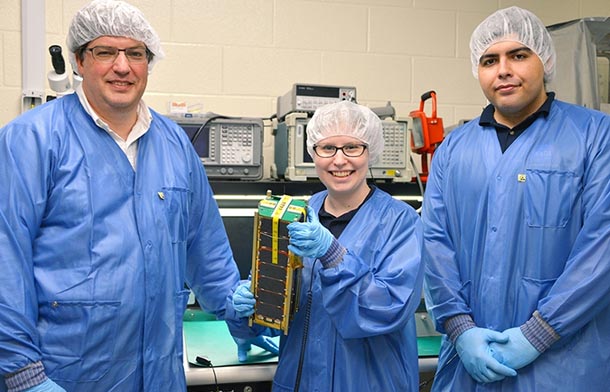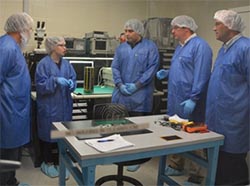
OSIRIS-3U Principal Investigator Sven Bilén (left) with SSPL students Rebecca Arenson (middle) and Sergio Gallucci (right) display the CubeSat in its launch configuration before heading to Houston, Texas, for integration with the Nanoracks deployer.
Student-built satellite aims to provide insight on effects of solar storms
6/22/2017
UNIVERSITY PARK, Pa. — This summer, astronauts on the International Space Station will launch a Penn State student-built satellite into orbit that will help learn more about space weather.
The OSIRIS-3U satellite, delivered in its launch configuration this month, was designed and built over the past five years by students working in the Student Space Programs Laboratory (SSPL). When in orbit, it will provide measurements of the heated ionosphere to better understand space weather phenomena.
“When you get up in the morning and want to figure out what to wear, you look at the forecast in a weather app on your phone. We’re used to terrestrial weather and how it affects our lives, but we’re not very aware of space weather, even though it, too, can have a huge effect on our lives,” Sven Bilén, director of the lab and professor of engineering design, electrical engineering, aerospace engineering and department head of the School of Engineering Design, Technology, and Professional Programs, said. “Each day we rely on satellites, fly in airplanes, get power from power grids and rely on GPS signals. These things are all affected by space weather – and a big weather event, like a massive solar storm in 1859, could devastate modern society. We want to be able to better understand various space weather phenomena.”
Because the space weather caused by the Sun is so unpredictable, the students’ mission is to create similar effects by heating the ionosphere with the help of the Arecibo Observatory in Puerto Rico. The satellite will be able to collect GPS scintillation data and electron density and temperature measurements in this simulated solar storm so the students can learn more about space weather and its ramifications on Earth.
“The results of this mission will provide us with a lot of scientific information,” said Andrew O’Neill, manager of SSPL and a senior electrical engineering student from West Grove, Pa. “Hopefully we’ll have a better idea of the effects of solar flares and the disruptions of communications they may cause between Earth and our satellites.”
According to their proposal to NASA, spearheaded by Penn State electrical engineering alumnus Kyle Botteon while he was still a student, with help from Bilén—and which won them the launch — their satellite was designed to fit into a three-unit, or “3U”, CubeSat form factor. One unit supports the scientific instruments and two units are devoted to the bus that runs the satellite, which includes the structure, a power distribution system, attitude control system, communications system and command and data handling system. The bus electronics are built around two stacks of circuit boards.
SSPL partnered with Aerospace Corporation and the Naval Research Lab to provide two of the scientific instruments, and a third was built in-house by students. All instruments will measure different aspects of the plasma environment.
This past semester students finished the construction and tested all the pieces of the satellite to ensure it could handle the rough journey into space. Funding to complete the satellite came from businesses like Boeing and Lockheed Martin, and from the Pennsylvania Space Grant Consortium. This month, Penn State students delivered the satellite in person to Nanoracks, the company contracted by NASA to coordinate its launch. The satellite will be carried to the ISS on a SpaceX rocket launched from Florida. The data collected by OSIRIS-3U will start to be downlinked by the end of the summer, and students in the lab will write and publish papers on what they’ve learned.
“SSPL has been very successful in training future engineers,” said Rebecca Arenson, of Merion Station, Pa., who graduated from Penn State with a bachelor’s degree in electrical engineering on May 5. “The lab gives students great hands-on experience that they wouldn’t get just anywhere and it’s very valuable in industry. A lot of the SSPL alumni secured internships at NASA’s Jet Propulsion Laboratory or Boeing as students and are now working there full-time.”




